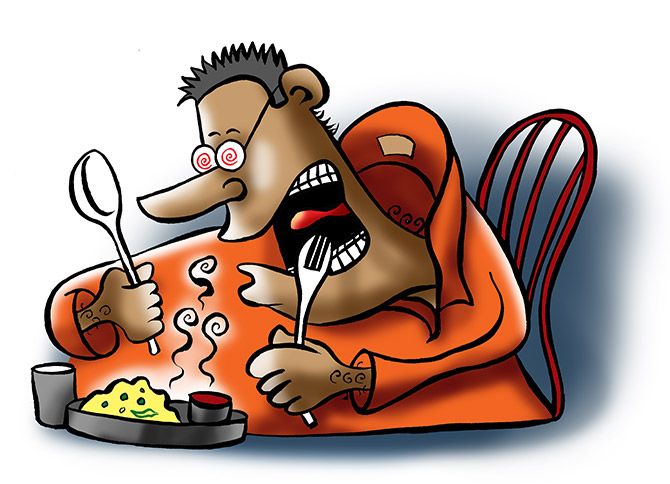 | « Back to article | Print this article |
'A hangover of the Raj, there's no one quite like the desi butler who knows the order in which a meal must be served, and will not be distracted from his watch by modern memsahibs and their slightly unusual ways or requests,' says Kishore Singh.
Illustration: Uttam Ghosh/Rediff.com

I'm a sucker for a sit-down dinner, served course by course, with appropriate crockery and cutlery -- alas, the preserve mostly of official banquets where the meal itself counts for little, or the occasional corporate jamboree that is likely to be stiff and uneven because there's an agenda -- and speeches -- that accompany most such meals.
It was a pleasure, therefore, to be seated in a civilised manner at the home of a retired diplomat whose wife had taken the trouble of laying out an elegant feast, even though we behaved like barbarians at the table.
No, not because we embarrassed ourselves picking up the wrong spoon, or fork, but because we pigged out in a way more suited to buffets than a meal served formally.
Fine dining is more often ruined by manners than the quality of the meal itself.
When our soup was served, we expected nothing more than a main course to follow. The beautifully baked pies, piping hot and melting cheese straight out of the oven and served individually, turned out to be an entree, generous portions that we unfortunately assumed and ate like dinner.
When the main course consisting of several dishes followed, we found ourselves sated -- but unable to protest given the effort put into the preparation and serving.
We were bursting by the time the desserts arrived, a brilliant meal eaten over charming conversation, a reminder of one's growing up years when you only invited as many guests as the table could seat, and meals went on over hours.
On Civvy Street, such considerations are a luxury. You may find a seat at the table, but for all practical purposes the meal is still a buffet, however splendid its offerings.
The fare at a babu's official residence may be more modest by comparison, but you can be sure it will be served with flair.
A hangover of the Raj, there's no one quite like the desi butler who knows the order in which a meal must be served, and will not be distracted from his watch by modern memsahibs and their slightly unusual ways or requests.
Sarkari houses are usually old, held together by paint and polish, but they come with their perks -- I speak at the senior-most levels, of course -- furniture varnished to a shine (if a little scuffed from use), sprawling carpets (hand-knotted, not machine-made), electricians and plumbers on call, gardens with attendant maalis, lovely ancient trees with bats and monkeys as residents.
Some keep hens and get fresh eggs. There's room and more for pets and staff to groom them. And no fear that the cook and masalchi will be on leave at the same time without a replacement.
You and I may have got into the habit of drinking tea from mugs, but in this privileged world tea is still 'eaten', served on gigantic trays, in delicate bone china sets, accompanied by serviettes, with dainty silver spoons, pots and bowls.
Trolleys groaning with food are wheeled in, reminding us of why teas used to be a favourite childhood meal, easy to put together with samosas from the neighbourhood shop, mince kebabs made by the cook, cookies and, of course, a cake as highlight.
Nimbupani and chai too, which is why an 'official' tea is my favourite invitation that I am happy to accept with alacrity, no matter how inconvenient the timing for those of us who work in the private sector. And even if tea isn't my preferred beverage.